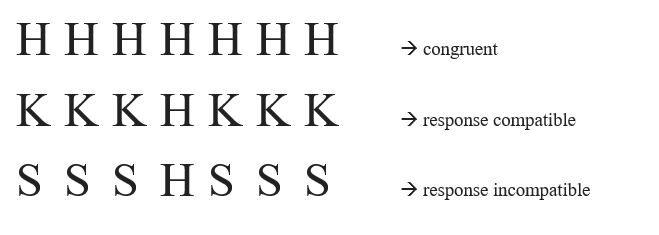In short
The Flanker task (or Eriksen Flanker task) is a well-known experiment in Psychology, and it was first carried out by B. A. Eriksen and C. W. Eriksen (1974). The name ‘Flanker’ comes from the flanker stimuli surrounding the target. The Flanker task measures the average reaction time between incongruent and congruent trials and can be used to study populations with neurological and/or mental health problems.
The Flanker Task
In the original Flanker task, the central target letter stimulus was surrounded by flanking letters and participants were asked to respond left or right according to task instructions via lever presses. The flanker letters surrounding the target letter could be the same (congruent trials), different while participants were asked to respond in the same way (response compatible), or indicating that the participant press the other lever instead (response incompatible). For example, letters H and K required the same lever to be pressed, whereas S required the other lever, as seen in the example below.

Nowadays, the task is often done with arrows pointing either to the left or to the right and some experiments also include neutral trials, where the flankers are replaced by squares and only the target points in one direction. Participants are asked to respond, trial by trial, to the direction of the target (middle arrow) and to ignore the distracter flankers, while their reaction times are being recorded. Click on the image below to see how you can set this up in Gorilla.
The Flanker task can be adapted to a lot of different situations, for example, by using numbers or colour patches instead of letters or arrows. All of them are based on interference between a target stimulus and several distracter elements.
In Gorilla, we have used a Flanker task as a game with fish. Check it out by clicking the image below.
What is the Flanker Effect?
The Flanker Effect is the calculated difference between measured average reaction times to incongruent and congruent trials. The results typically show that the distracters interfere with the correct and goal-directed reporting of the target, as reaction times to congruent stimuli are usually a lot faster than for incongruent stimuli. The Flanker Effect is sometimes referred to as a compatibility, interference, or congruency/incongruency effect, and similar effects are seen in other tasks which contain congruent and incongruent stimuli and induce stimulus-response conflict, such as in the Stroop task.
What is the theory behind the Flanker Effect?
There are several theories behind the Flanker Effect, mainly regarding attentional processes, speed of processing, and inhibition. Indeed, participants have to inhibit their reaction to the distracter stimuli and instead respond to the target stimulus in the middle.
Can I use the Flanker task in online research?
Yes, absolutely! In fact, we have already tested this ourselves (Anwyl-Irvine et al., 2020) and made the materials for our Flanker task available. Although Flanker effects in our data were slightly smaller than in a lab-based setting, they were significant and replicated the original findings.
How does it work in Gorilla?
You can try out and clone our sample of the Flanker task. We have a standard version with arrows and a gamified version in an under-water setting. Of course, you can also tweak these samples, use your own stimuli, and change the feedback, for example.
Version with arrows in the Task Builder 2: Try out the Flanker task
Version with fish in the Game Builder: Try out the Flanker game
Are there any papers Gorilla users have written using the Flanker task?
Yes, there are! Have a look at the following articles:
Distractor probabilities modulate flanker task performance
Task-specific bilingual effects in Mandarin-English speaking high school students in China
References
Anwyl-Irvine, A. L., Massonié, J., Flitton, A., Kirkham, N., & Evershed, J. K. (2020). Gorilla in our midst: An online behavioral experiment builder. Behavior Research Methods, 52, 388-407. https://doi.org/10.3758/s13428-019-01237-x
Eriksen, B. A., & Eriksen, C. W. (1974). Effects of noise letters upon the identification of a target letter in a nonsearch task. Perception & psychophysics, 16(1), 143-149. https://doi.org/10.3758/BF03203267